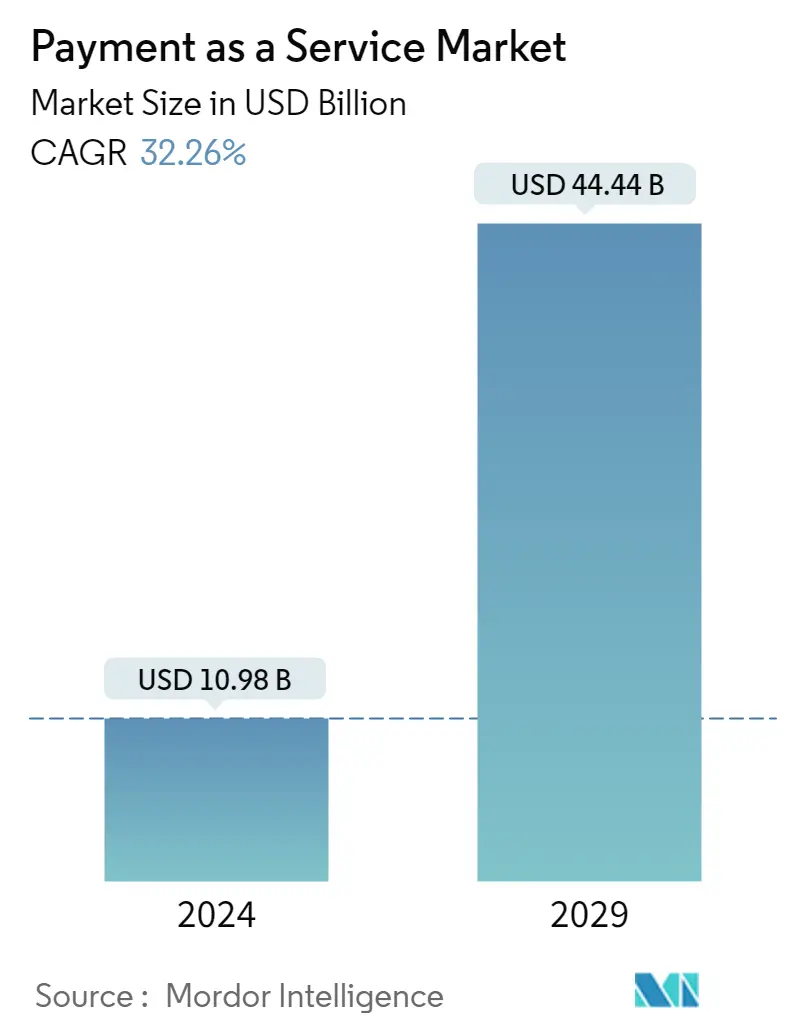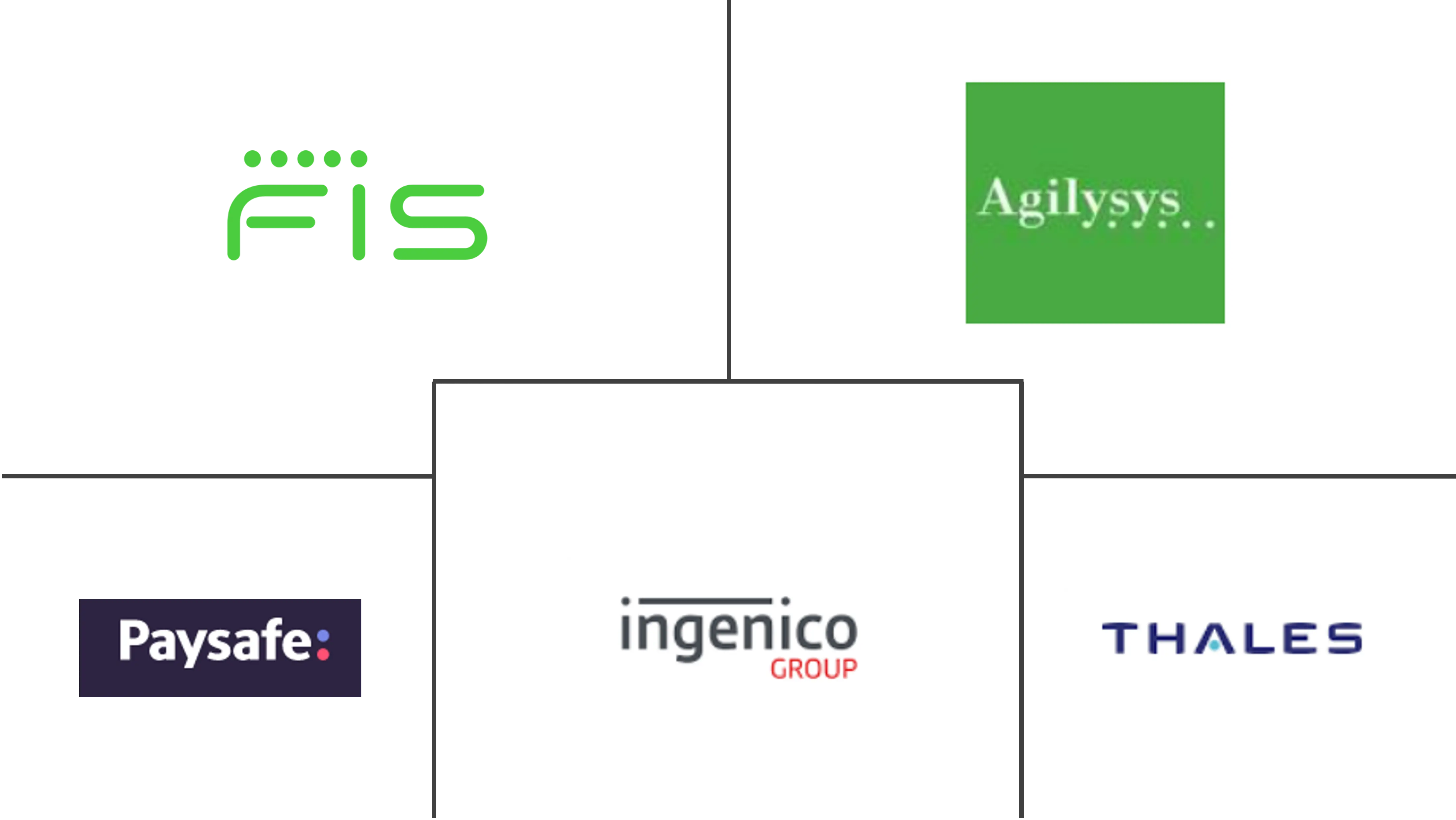Market Size of Payment as a Service Industry

| Study Period | 2021 - 2029 |
| Market Size (2024) | USD 10.98 Billion |
| Market Size (2029) | USD 44.44 Billion |
| CAGR (2024 - 2029) | 32.26 % |
| Fastest Growing Market | Asia Pacific |
| Largest Market | North America |
| Market Concentration | Low |
Major Players
*Disclaimer: Major Players sorted in no particular order |
Payment as a Service (PAAS) Market Analysis
The Payment as a Service Market size is estimated at USD 10.98 billion in 2024, and is expected to reach USD 44.44 billion by 2029, growing at a CAGR of 32.26% during the forecast period (2024-2029).
In the current scenario, the increasing smartphone penetration is proliferating the growth of the sale of goods and services extensively through mobile apps to assist customers by providing an easy and convenient shopping experience. The rise in demand for easy and convenient purchases of goods and services resulted in a radical shift toward digital and cashless payments. The increase in e-commerce business further boosts the global payment service provider market.
- The business is anticipated to increase due to efforts being made in numerous nations to promote digital and online transactions. The expansion of the PaaS market is also expected to be aided by the advent of payment networks like Mastercard, Visa, and Rupay on a global scale for the processing of smooth payments for clients.
- The increased demand for smartphone penetration and the incorporation of online services is experiencing continuous growth. It is expected to maintain its dominance in the market with an increase in emphasis on smartphone usage and massive internet penetration across the world. In addition, customers are using online payment channels more frequently as banks and financial institutions provide real-time payment services. Therefore, demand for online payments is experiencing a continuous rise in the market.
- The payment industry has experienced a significant transformation, and the old methods are replaced with new modules with a single click. Moreover, payment as a service (PaaS) is not only changing the scene for retailers. Banks are now realizing that the rise in PaaS use is an opportunity to give their clients a reliable choice. Thus, the increasing dependence on e-commerce, especially in retail, drives the payment as a service market.
- The absence of a global standard for cross-border transactions could restrain the market. Due to the lack of a worldwide payment system that is simple to use, international standards, and differing government rules in different countries, banks and businesses may be negatively impacted. This frequently necessitates manual intervention to gather and correct data.
- The COVID-19 pandemic has significantly impacted the payment as a service industry, owing to the increased usage and adoption of online and digitalized payment methods among consumers globally. Additionally, payment as a service is experiencing massive growth as consumers become familiar with the payment technology in the market. However, post-pandemic, there was a significant rise in the adoption of digital payments, reducing the trend of carrying and paying through cash which, in turn, has become one of the primary growth factors for the payment as a service market.
Payment as a Service (PAAS) Industry Segmentation
A payment service provider offers online services to accept electronic payments through various payment methods, such as credit card, direct debit, bank transfer, and real-time bank transfer. The payment service provider uses the software as a service model widely. A payment service provider connects multiple banks, cards, and payment networks.
The payment as a service market is segmented by type of services (merchant financing, regulatory compliance, security and fraud protection, payment applications and gateways), end-user industry (retail and e-commerce, BFSI, hospitality, media and entertainment, healthcare), and geography. The market sizes and forecasts are provided in terms of value (USD billion) for all the above segments.
| By Types of Services | |
| Merchant Financing | |
| Regulatory Compliance | |
| Security and Fraud Protection | |
| Payment Applications and Gateways | |
| Other Services |
| By End-user Industry | |
| Retail and E-commerce | |
| BFSI | |
| Hospitality | |
| Media and Entertainment | |
| Other End-user Industries |
| By Geography | |||||||
| |||||||
| |||||||
| |||||||
| |||||||
|
Payment as a Service Market Size Summary
The Payment as a Service (PaaS) market is experiencing rapid expansion, driven by the increasing adoption of digital and cashless payment solutions globally. This growth is largely fueled by the proliferation of smartphones and the rise of e-commerce, which have transformed consumer purchasing behaviors towards more convenient and efficient online transactions. The market is further bolstered by the efforts of various countries to promote digital transactions and the global presence of major payment networks like Mastercard, Visa, and Rupay. These developments are reshaping the payment landscape, offering retailers and banks opportunities to enhance customer experiences and streamline payment processes. However, challenges such as the lack of global standards for cross-border transactions and varying regulatory environments continue to pose obstacles to market growth.
The Asia-Pacific region is poised for significant growth in the PaaS market, driven by advancements in payment technologies and increased smartphone and internet penetration. Countries like China, Japan, and Australia are at the forefront of this expansion, with initiatives such as the Asian Payments Network facilitating cross-border transactions. The shift from cash to digital payments among small retailers, spurred by government policies like India's demonetization, highlights the region's rapid adoption of digital payment solutions. The competitive landscape of the PaaS market is characterized by numerous providers focusing on innovation and strategic partnerships to enhance their market presence. Notable developments include collaborations between companies like Adyen and Instacart, and Ingenico and Live Payments, which aim to offer seamless payment solutions across various sectors.
Payment as a Service Market Size - Table of Contents
-
1. MARKET DYNAMICS
-
1.1 Market Overview
-
1.2 Market Drivers
-
1.2.1 Increased Demand for Smartphone Penetration and Incorporation of Online Services
-
1.2.2 Increase Dependence on E-Commerce Platform
-
-
1.3 Market Restraints
-
1.3.1 Absence of Global Standards for Payments
-
-
1.4 Industry Value Chain Analysis
-
1.5 Industry Attractiveness - Porter's Five Force Analysis
-
1.5.1 Bargaining Power of Suppliers
-
1.5.2 Bargaining Power of Buyers/Consumers
-
1.5.3 Threat of New Entrants
-
1.5.4 Threat of Substitute Products
-
1.5.5 Intensity of Competitive Rivalry
-
-
1.6 Impact of COVID-19 on the Market
-
-
2. MARKET SEGMENTATION
-
2.1 By Types of Services
-
2.1.1 Merchant Financing
-
2.1.2 Regulatory Compliance
-
2.1.3 Security and Fraud Protection
-
2.1.4 Payment Applications and Gateways
-
2.1.5 Other Services
-
-
2.2 By End-user Industry
-
2.2.1 Retail and E-commerce
-
2.2.2 BFSI
-
2.2.3 Hospitality
-
2.2.4 Media and Entertainment
-
2.2.5 Other End-user Industries
-
-
2.3 By Geography
-
2.3.1 North America
-
2.3.1.1 United States
-
2.3.1.2 Canada
-
-
2.3.2 Europe
-
2.3.2.1 United Kingdom
-
2.3.2.2 Germany
-
2.3.2.3 France
-
2.3.2.4 Rest of Europe
-
-
2.3.3 Asia-Pacific
-
2.3.3.1 China
-
2.3.3.2 Japan
-
2.3.3.3 South Korea
-
2.3.3.4 Australia
-
2.3.3.5 Rest of Asia-Pacific
-
-
2.3.4 Latin America
-
2.3.4.1 Mexico
-
2.3.4.2 Brazil
-
2.3.4.3 Rest of Latin America
-
-
2.3.5 Middle East and Africa
-
2.3.5.1 United Arab Emirates
-
2.3.5.2 Saudi Arabia
-
2.3.5.3 Rest of Middle East and Africa
-
-
-
Payment as a Service Market Size FAQs
How big is the Payment as a Service Market?
The Payment as a Service Market size is expected to reach USD 10.98 billion in 2024 and grow at a CAGR of 32.26% to reach USD 44.44 billion by 2029.
What is the current Payment as a Service Market size?
In 2024, the Payment as a Service Market size is expected to reach USD 10.98 billion.

